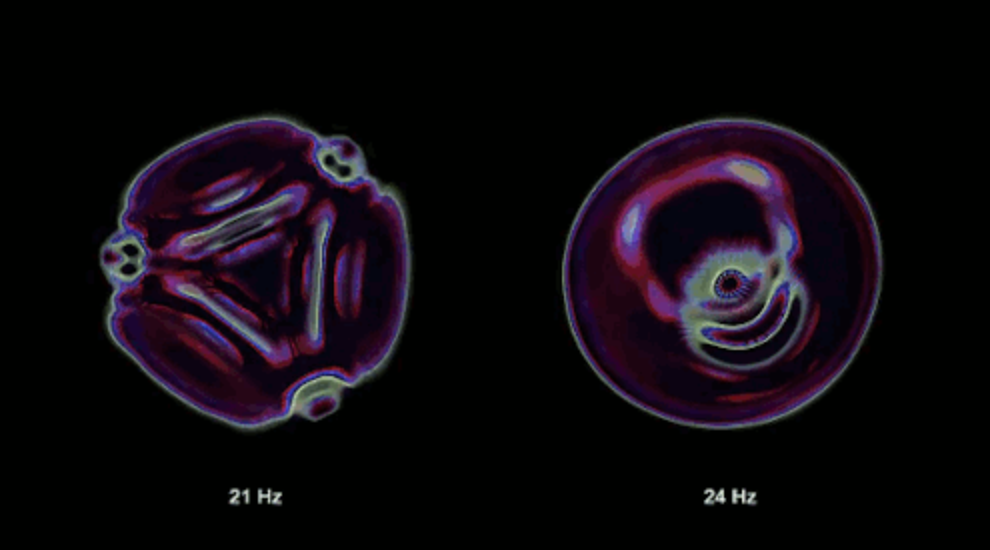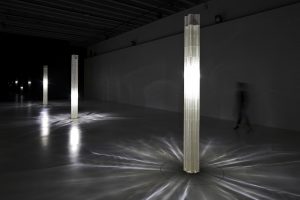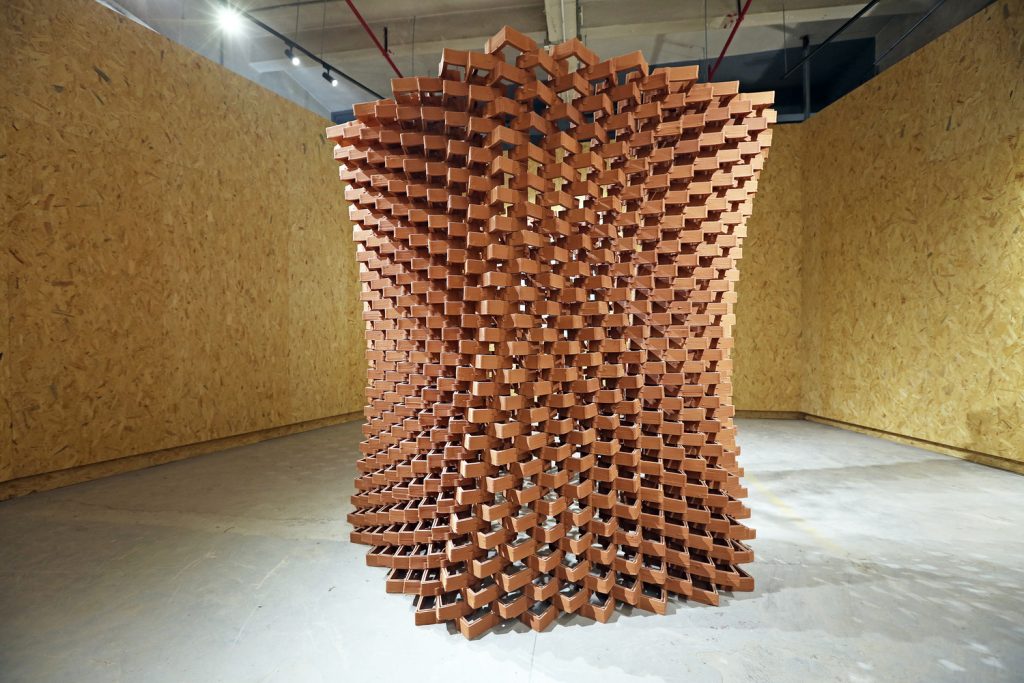sketch
/* Cathy Dong
Section D
yinhuid
Project 3-Dynamic Drawing
*/
var skyR = 139;
var skyG = 212;
var skyB = 229;
var moonCut = 0;
var sunDia = 100;
var starAngle = 0;
var starR = 249;
var starG = 215;
var starB = 81;
var starW = 10;
var starH = 12;
function setup() {
createCanvas(640, 480);
}
function draw() {
background(skyR, skyG, skyB);
var winR = 254;
var winG = 221;
var winB = 2;
//stars
noStroke();
fill(starR,starG,starB);
//star 1
push();
translate(640 - mouseX, 100);
rotate(radians(starAngle));
rectMode(CENTER);
rect(0, 0, starW, starH);
pop();
//star 2
push();
translate(800 - mouseX, 150);
rotate(radians(starAngle));
rectMode(CENTER);
rect(0, 0, starW, starH);
pop();
//star 3
push();
translate(760 - mouseX, 120);
rotate(radians(starAngle));
rectMode(CENTER);
rect(0, 0, starW, starH);
pop();
//star 4
push();
translate(900 - mouseX, 20);
rotate(radians(starAngle));
rectMode(CENTER);
rect(0, 0, starW, starH);
pop();
//star 5
push();
translate(500 -mouseX, 50);
rotate(radians(starAngle));
rectMode(CENTER);
rect(0, 0, starW, starH);
pop();
//star 6
push();
translate(760 - mouseX, 80);
rotate(radians(starAngle));
rectMode(CENTER);
rect(0, 0, starW, starH);
pop();
//star 7
push();
translate(1000 - mouseX, 60);
rotate(radians(starAngle));
rectMode(CENTER);
rect(0, 0, starW, starH);
pop();
//star 8
push();
translate(1500 - mouseX, 50);
rotate(radians(starAngle));
rectMode(CENTER);
rect(0, 0, starW, starH);
pop();
//star 9
push();
translate(1200 - mouseX, 30);
rotate(radians(starAngle));
rectMode(CENTER);
rect(0, 0, starW, starH);
pop();
//star 10
push();
translate(320 - mouseX, 100);
rotate(radians(starAngle));
rectMode(CENTER);
rect(0, 0, starW, starH);
pop();
//star 11
push();
translate(200 - mouseX, 130);
rotate(radians(starAngle));
rectMode(CENTER);
rect(0, 0, starW, starH);
pop();
//trinkle stars
starAngle += mouseX;
//night
if (mouseX > width / 2) {
//star size
starW = 10;
starH = 12;
//show star
starR = 249;
starG = 215;
starB = 81;
//sky color
skyR = 61;
skyG = 80;
skyB = 92;
//moon
noStroke();
fill(255, 216, 0);
ellipse(mouseX, mouseX - 200, 200,200);
//moon change
noStroke();
fill(skyR, skyG, skyB);
moonCut = map(mouseX, 240, 640, 0, 400);
ellipse(mouseX - 75, mouseX - 200, moonCut, moonCut);
}
//morning
else if (mouseX <= width / 2) {
//hide star
starR = 255;
starG = 240;
starB = 154;
//star size
starW = 42 - mouseX / 10;
starH = 42 - mouseX / 10 + 2;
//sky color
skyR = 156;
skyG = 215;
skyB = 255;
//window color
winR = 255;
winG = 240;
winB = 154;
//sun
noStroke();
fill(255, 240, 154);
sunDia = map(mouseX, 0, 320, 30, 200);
ellipse(mouseX, height - mouseX - 40, sunDia, sunDia);
}
//haunted house black
noStroke();
fill(0);
beginShape();
vertex(270, 416);
vertex(253, 323);
vertex(242, 323);
vertex(269, 270);
vertex(245, 257);
vertex(235, 206);
vertex(251, 206);
vertex(254, 253);
vertex(273, 264);
vertex(284, 236);
vertex(325, 273);
vertex(324, 160);
vertex(315, 159);
vertex(333, 132);
vertex(350, 93);
vertex(354, 138);
vertex(367, 166);
vertex(358, 164);
vertex(370, 238);
vertex(375, 234);
vertex(384, 278);
vertex(353, 351);
vertex(324, 415);
endShape(CLOSE);
//haunted house color left chimney
noStroke();
fill(10, 24, 25);
beginShape();
vertex(251, 206);
vertex(254, 253);
vertex(273, 264);
vertex(275, 260);
vertex(262, 250);
vertex(266, 218);
endShape(CLOSE);
//haunted house color left roof side
noStroke();
fill(20, 53, 60);
beginShape();
vertex(335, 310);
vertex(398, 343);
vertex(389, 344);
vertex(320, 314);
endShape(CLOSE);
//haunted house color left wall
noStroke();
fill(39, 83, 94);
beginShape();
vertex(320, 314);
vertex(389, 344);
vertex(377, 420);
vertex(325, 415);
endShape(CLOSE);
//haunted house upper color roof
noStroke();
fill(10, 24, 25);
beginShape();
vertex(350, 93);
vertex(354, 138);
vertex(367, 166);
vertex(389, 176);
vertex(372, 129);
endShape(CLOSE);
//haunted house color upper roof side
noStroke();
fill(20, 53, 60);
beginShape();
vertex(367, 166);
vertex(389, 176);
vertex(379, 177);
vertex (357, 164);
endShape(CLOSE);
//haunted house color upper roof wall
noStroke();
fill(39, 83, 94);
beginShape();
vertex(370, 238);
vertex(353, 252);
vertex(358, 164);
vertex(378, 176);
endShape(CLOSE);
//haunted house color right roof
noStroke();
fill(10, 24, 25);
beginShape();
vertex(375, 234);
vertex(384, 278);
vertex(412, 306);
vertex(401, 273);
endShape(CLOSE);
//haunted house color right roof side
noStroke();
fill(20, 53, 60);
beginShape();
vertex(384, 278);
vertex(412, 306);
vertex(407, 308);
vertex(378, 278);
endShape(CLOSE);
//haunted house color right wall
noStroke();
fill(39, 83, 94);
beginShape();
vertex(407, 308);
vertex(378, 278);
vertex(366, 312);
vertex(390, 337);
endShape(CLOSE);
//haunted house color left roof
noStroke();
fill(10, 24, 25);
beginShape();
vertex(284, 236);
vertex(325, 273);
vertex(398, 343);
vertex(335, 310);
endShape(CLOSE);
//front ground
noStroke();
fill(0);
beginShape();
curveVertex(0, 640);
curveVertex(0, 360);
curveVertex(0, 360);
curveVertex(68, 400);
curveVertex(137, 412);
curveVertex(183, 423);
curveVertex(225, 413);
curveVertex(295, 410);
curveVertex(254, 413);
curveVertex(320, 410);
curveVertex(409, 423);
curveVertex(477, 403);
curveVertex(550, 400);
curveVertex(640, 425);
curveVertex(640, 480);
endShape(CLOSE);
//windows lights
noStroke();
fill(winR, winG, winB);
//left long
beginShape();
vertex(279, 329);
vertex(283, 364);
vertex(298, 362);
vertex(293, 331);
vertex(288, 324);
vertex(283, 324);
endShape(CLOSE);
//left ellipse
ellipse(289, 286, 18, 22);
//upper short
beginShape();
vertex(353, 272);
vertex(368, 277);
vertex(362, 293);
vertex(351, 286);
endShape(CLOSE);
//upper long
beginShape();
vertex(331, 205);
vertex(347, 207);
vertex(347, 172);
curveVertex(340, 166);
curveVertex(333, 171);
endShape(CLOSE);
//window frame
noFill();
stroke(0);
strokeWeight(1);
//upper long
line(333, 177, 348, 180);
line(331, 186, 348, 188);
line(332, 194, 349, 197);
line(339, 166, 339, 206);
//left long
line(279, 335, 294, 332);
line(281, 344, 296, 342);
line(280, 354, 296, 351);
line(284, 322, 292, 364);
//window no lights
noStroke();
fill(0);
//window 1
beginShape();
vertex(330, 323);
vertex(330, 340);
vertex(347, 348);
vertex(348, 334);
endShape(CLOSE);
//window 2
beginShape();
vertex(329, 362);
vertex(331, 376);
vertex(348, 382);
vertex(348, 368);
endShape(CLOSE);
//window 3
beginShape();
vertex(383, 293);
vertex(378, 305);
vertex(391, 317);
vertex(398, 308);
endShape(CLOSE);
//window 4
beginShape();
vertex(364, 172);
vertex(362, 205);
vertex(370, 207);
vertex(373, 182);
endShape(CLOSE);
//door outline
beginShape();
vertex(360, 370);
vertex(357, 450);
vertex(368, 450);
vertex(376, 377);
endShape(CLOSE);
//door window light
noStroke();
fill(winR, winG, winB);
beginShape();
vertex(363, 375);
vertex(363, 388);
vertex(371, 391);
vertex(371, 380);
endShape(CLOSE);
//upper chimney
noStroke();
fill(0);
beginShape();
vertex(356, 123);
vertex(365, 114);
vertex(368, 100);
vertex(365, 98);
vertex(376, 77);
vertex(380, 102);
vertex(376, 102);
vertex(373, 119);
vertex(363, 127);
endShape(CLOSE);
}
In this Dynamic Drawing project, I made a haunted house. I used color shades to add a 3D effect. By moving mouse left and right, the scene changes from night to morning. The moon and sun changes shape, location, and dimension, whereas the stars at night changes rotation speed and direction. The haunted house itself changes light color.
![[OLD FALL 2019] 15-104 • Introduction to Computing for Creative Practice](../../../../wp-content/uploads/2020/08/stop-banner.png)



